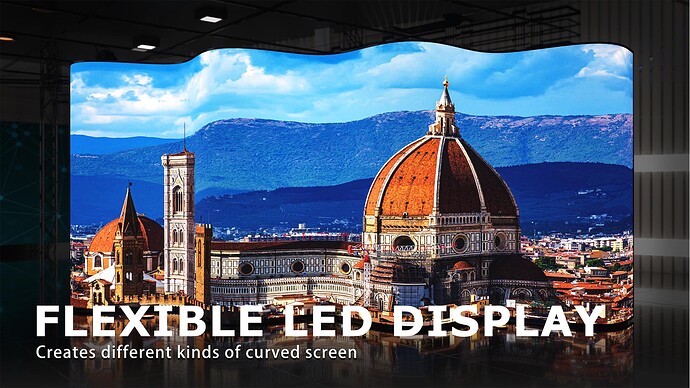- Introduction
Rapid advances in flexible LED screen technology are changing the way we perceive digital displays. From curved designs to curved screens, the flexibility and versatility of Flexible LED Screens opens up endless possibilities for a wide range of industries. In this article, let’s explore the applications and benefits of this innovative technology in different fields.
2.What is flexible LED screen?
Flexible LED screen is a display technology that utilizes light emitting diodes (LEDs) mounted on a flexible substrate to allow the screen to bend and flex without compromising image quality. Unlike traditional rigid LED screens, flexible LED screens can be adapted to a variety of shapes and surfaces, providing greater flexibility in design and application.
Key Features:
Flexibility: The key feature of flexible LED screen is their ability to bend and adapt to different shapes, making them suitable for both creative and unconventional installations.
High Resolution: Despite their flexibility, these screens offer high resolution and brightness, ensuring clear displays and vibrant colors.
Lightweight: Flexible LED screens are typically lighter than rigid screens, making them easy to transport and install. - Flexible LED display in various industries
4.1 Retail and Advertising
In retail and advertising, flexible LED screens can create displays to attract customers. For example, in high-end fashion stores, flexible LED screens can be used to display dynamic video content that wraps around columns and corners, creating an immersive shopping experience. Outdoor billboards with flexible LED technology can be adapted to a variety of shapes, allowing for innovative and eye-catching advertisements.
4.2 Entertainment and Events
Flexible LED wall is widely used in concerts, theaters and large-scale events to enhance the visual experience. For example, at concerts, flexible LED screens can form a curved backdrop that displays synchronized visuals to enhance the performance. In theaters, these screens can be used to create dynamic sets that change quickly between scenes, providing versatile and engaging stage design.
4.3 Corporate and Office Spaces
In corporate environments, flexible LED screens are used for presentations, video conferencing and branding. For example, in the lobby of a technology company, large flexible LED screens can display real-time data, company news and product demonstrations, creating a modern and high-tech atmosphere. In conference rooms, these screens can be used for videoconferencing, providing clear and bright visuals.
4.4 Museums and Exhibitions
In museums and exhibition spaces, flexible LED screens are used to create interactive and educational displays. For example, a museum can use a flexible LED wall to create a curved display that guides visitors through an exhibit with animated content and informational videos. This can enhance storytelling and provide a better visitor experience.
If you want to know more about flexible LED screen, contact us now.
